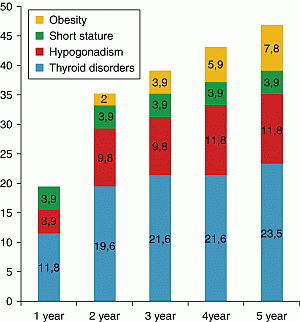ICEECE2012 Poster Presentations Developmental endocrinology (18 abstracts)
The development of endocrinologic dysfunction after allogeneic HSCT in children.
I. Ben-Skowronek , K. Drabko , B. Wójcik & J. Kowalczyk
Medical University, Lublin, Poland.
Introduction: Endocrinologic dysfunction is a well-known complication after hematopoietic stem cell transplantation (HSCT) in children. The mechanisms of thyroid damage developing after transplantation remain not completely recognized. Toxicity of the conditioning regimen, especially total body irradiation, is most commonly postulated cause of endocrine abnormalities; immunological mechanisms (e.g. graft vs host disease) may also contribute to thyroid dysfunction.
Patients and methods: We prospectively evaluated the function of thyroid, gonads, pituitary and adrenals in 51 children, aged 1–18 years, who survived more than one year after transplantation. The reasons for bone marrow transplantation were: severe aplastic anemia (SAA), acute lymphoblastic anemia, inborn errors, acute myeloblastic leukemia and others. The conditioning regimen included chemotherapy in 27 children and TBI in eight patients.
In the Endocrinological Dept. the high velocity and sexual maturation of the children were observed. Every year we evaluated TSH, fT4, anti-tyreoglobuline antibodies (a-TG) and anti-peroxidase antibodies (a-TPO), FSH, LH, prolactin, estradiol and testosterone, GH, glycemia, lipidogram, insulin and glucose levels and circadian rhythm of cortisole secretion.
Results: In eight children, autoimmune hypothyroidism was diagnosed; the children needed L-thyroxin replacement therapy. In three patients this feature was transient, while four required thyroxin supplementation. One patient was diagnosed as having Graves’ disease. Transient delay of growth velocity was observed in all the children in the first year after HSCT, but only in 2 boys they were permanent; however the growth hormone secretion in sleep was normal. In six children hypogonadism was developed – in four hypergonadotropic hypogonadism and in two hypogonadotropic hypogonadism. Three children were treated for obesity without adrenal and pancreatic disorders.
Conclusions: 1. Abnormalities of autoimmunological thyroid function are a most frequent complication in children after HSCT.
2. The frequent complication is hyper- and hypogodotropic gonad disorders.
3. The children after HSCT need permanent observation in the Endocrinological Outpatient Clinic.
The percentage of endocrine disorders after allogeneic HSCT.

Declaration of interest: The authors declare that there is no conflict of interest that could be perceived as prejudicing the impartiality of the research project.
Funding: This research did not receive any specific grant from any funding agency in the public, commercial or not-for-profit sector.




